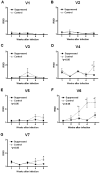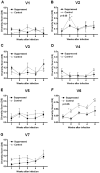Antigenic variation in Treponema pallidum: TprK sequence diversity accumulates in response to immune pressure during experimental syphilis
- PMID: 20190145
- PMCID: PMC3042355
- DOI: 10.4049/jimmunol.0902788
Antigenic variation in Treponema pallidum: TprK sequence diversity accumulates in response to immune pressure during experimental syphilis
Abstract
Pathogens that cause chronic infections often employ antigenic variation to evade the immune response and persist in the host. In Treponema pallidum (T. pallidum), the causative agent of syphilis, the TprK Ag undergoes variation of seven V regions (V1-V7) by nonreciprocal recombination of silent donor cassettes with the tprK expression site. These V regions are the targets of the host humoral immune response during experimental infection. The present study addresses the causal role of the acquired immune response in the selection of TprK variants in two ways: 1) by investigating TprK variants arising in immunocompetent versus immunosuppressed hosts; and 2) by investigating the effect of prior specific immunization on selection of TprK variants during infection. V region diversity, particularly in V6, accumulates more rapidly in immunocompetent rabbits than in pharmacologically immunosuppressed rabbits (treated with weekly injections of methylprednisolone acetate). In a complementary experiment, rabbits preimmunized with V6 region synthetic peptides had more rapid accumulation of V6 variant treponemes than control rabbits. These studies demonstrate that the host immune response selects against specific TprK epitopes expressed on T. pallidum, resulting in immune selection of new TprK variants during infection, confirming a role for antigenic variation in syphilis.
Figures





Similar articles
-
Longitudinal TprK profiling of in vivo and in vitro-propagated Treponema pallidum subsp. pallidum reveals accumulation of antigenic variants in absence of immune pressure.PLoS Negl Trop Dis. 2021 Sep 7;15(9):e0009753. doi: 10.1371/journal.pntd.0009753. eCollection 2021 Sep. PLoS Negl Trop Dis. 2021. PMID: 34492041 Free PMC article.
-
Antigenic variation of TprK facilitates development of secondary syphilis.Infect Immun. 2014 Dec;82(12):4959-67. doi: 10.1128/IAI.02236-14. Epub 2014 Sep 15. Infect Immun. 2014. PMID: 25225245 Free PMC article.
-
Non-pathogenic Borrelia burgdorferi expressing Treponema pallidum TprK and Tp0435 antigens as a novel approach to evaluate syphilis vaccine candidates.Vaccine. 2019 Mar 22;37(13):1807-1818. doi: 10.1016/j.vaccine.2019.02.022. Epub 2019 Feb 20. Vaccine. 2019. PMID: 30797635 Free PMC article.
-
Surface antigens of the syphilis spirochete and their potential as virulence determinants.Emerg Infect Dis. 1997 Jan-Mar;3(1):11-20. doi: 10.3201/eid0301.970102. Emerg Infect Dis. 1997. PMID: 9126440 Free PMC article. Review.
-
Polypeptides of Treponema pallidum: progress toward understanding their structural, functional, and immunologic roles. Treponema Pallidum Polypeptide Research Group.Microbiol Rev. 1993 Sep;57(3):750-79. doi: 10.1128/mr.57.3.750-779.1993. Microbiol Rev. 1993. PMID: 8246847 Free PMC article. Review.
Cited by
-
Redefining the treponemal history through pre-Columbian genomes from Brazil.Nature. 2024 Mar;627(8002):182-188. doi: 10.1038/s41586-023-06965-x. Epub 2024 Jan 24. Nature. 2024. PMID: 38267579 Free PMC article.
-
The major outer sheath protein (Msp) of Treponema denticola has a bipartite domain architecture and exists as periplasmic and outer membrane-spanning conformers.J Bacteriol. 2013 May;195(9):2060-71. doi: 10.1128/JB.00078-13. Epub 2013 Mar 1. J Bacteriol. 2013. PMID: 23457251 Free PMC article.
-
Characterizing the Syphilis-Causing Treponema pallidum ssp. pallidum Proteome Using Complementary Mass Spectrometry.PLoS Negl Trop Dis. 2016 Sep 8;10(9):e0004988. doi: 10.1371/journal.pntd.0004988. eCollection 2016 Sep. PLoS Negl Trop Dis. 2016. PMID: 27606673 Free PMC article.
-
Full-length TprK of Treponema pallidum subsp. pallidum in lipid nanodiscs is a monomeric porin.Enzyme Microb Technol. 2022 Jan;153:109897. doi: 10.1016/j.enzmictec.2021.109897. Epub 2021 Aug 25. Enzyme Microb Technol. 2022. PMID: 34670182 Free PMC article.
-
Comparative genomics and full-length Tprk profiling of Treponema pallidum subsp. pallidum reinfection.PLoS Negl Trop Dis. 2020 Apr 6;14(4):e0007921. doi: 10.1371/journal.pntd.0007921. eCollection 2020 Apr. PLoS Negl Trop Dis. 2020. PMID: 32251462 Free PMC article.
References
-
- Lukehart SA, Miller JN. Demonstration of the in vitro phagocytosis of Treponema pallidum by rabbit peritoneal macrophages. J Immunol. 1978;121:2014–2024. - PubMed
-
- Baker-Zander SA, Lukehart SA. Macrophage-mediated killing of opsonized Treponema pallidum. J Infect Dis. 1992;165:69–74. - PubMed
-
- Gjestland T. The Oslo study of untreated syphilis. Acta Dermato Venereol. 1955;35:11–368. - PubMed
-
- Azar HA, Pham TD, Kurban AK. An electron microscopic study of a syphilitic chancre. Engulfment of Treponema pallidum by plasma cells. Arch Pathol. 1970;90:143–150. - PubMed
Publication types
MeSH terms
Substances
Grants and funding
LinkOut - more resources
Full Text Sources
Medical
Molecular Biology Databases

